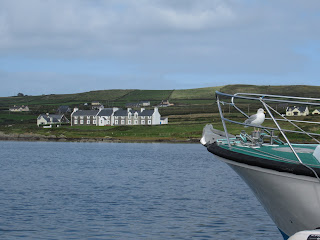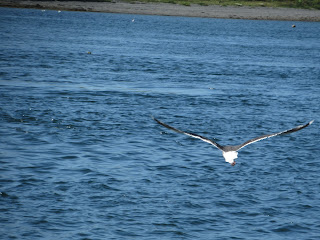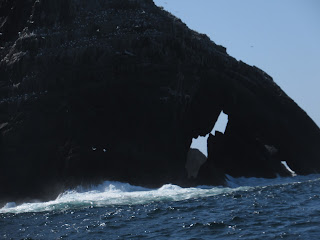Back in March when I was traveling with a friend in New Zealand, I got the long awaited email informing me that bookings were finally being accepted for a landing cruise to Skellig Michael from tiny Portmagee. I was so thrilled to then let Steven know we were lucky enough to be able to reserve two spots on the Celtic Victor 9:30 sailing to Skellig Michael as being able to land on the tiny island and then climb up to see the monastic settlement and beehive huts had been something we both really wanted to do this trip.
The Skelligs (Irish for 'splinter') are two massive slate and sandstone rocks about a 45 minute boat ride in good weather away from Portmagee on the southwest corner of Ireland. Skellig Michael, the bigger of the two, was named after the Archangel and was famous for being inhabited first by Christian monks in the 6th century.
The Skelligs (Irish for 'splinter') are two massive slate and sandstone rocks about a 45 minute boat ride in good weather away from Portmagee on the southwest corner of Ireland. Skellig Michael, the bigger of the two, was named after the Archangel and was famous for being inhabited first by Christian monks in the 6th century.
They sought the "purity of isolation to get closer to God" after being inspired by earlier hermit monks in the Egyptian desert. The monks built six small, stone igloo-shaped buildings, now described as beehive huts, as well as two tiny oratories or private chapels 600 feet above the sea. The monks accessed the huts after chiseling an amazing series of rock stairs from solid rock. They lived what's been described as a "harsh, lonely and disciplined existence" on Skellig Michael for over 500 years with neither Viking raids nor ferocious winter storms dislodging them. Viking Olav Trygvasson was baptized there in 993 before becoming king of Norway and introducing Christianity to his country.
The monks collected rainwater and survived by fishing and collecting birds' eggs. They traded the eggs and feathers with passing boats for candles and animal hides to be made into clothing and for copying religious works. Though they moved their religious community ashore in the early 12th century, Christian pilgrims continued to visit Skellig Michael for centuries as a penance.
After the final scenes of Star Wars: The Force Awakens were filmed on Skellig Michael, a landing visit on the island has become a very sought after ticket because only fifteen boats, each containing no more than 12 passengers are permitted to land per day during the fairly short season that's safe for boating.
We didn't think much of it when we got the email two days ahead saying our departure would be delayed until 11 as we thought it would simply give us an opportunity to first explore the lighthouse and slate quarry on Valentia Island before the four hour cruise and grueling hike up the mountain.
So, it was with great anticipation we boarded the small boat and donned our life jackets ready to leave for the adventure! However, after receiving radio reports from officials on Skellig Michael, Donel, the skipper told us we needed to wait until 12:50 so they could get a further weather update as, even though the weather looked fine and the seas were calm here in Portmagee Harbor, weather reports for landing conditions on Skellig Michael were different.
He mentioned the boats had only been able to land 5 times in the last 21 days because of the swells by the landing pier. That was a very tough break for all the boat owners because their season concluded at the end of September and they all depended on the tourists paying to land on Skellig Michael.
After walking around the harbor some more, we returned to the boat and finally took off even though we had no guarantee that we'd be able to land on the island. At that point, we were just glad to be off for a boat ride and anything more than that would be a bonus, we figured! I think our skipper said there were about a dozen other boats all in the 'same boat' so to speak in the sense of all hoping to land on the island.
On the right was the 100-yard bridge over to Valentia Island where we were staying for two nights.
It was only safe for us to be standing while in the harbor because, once we hit the open sea, the winds picked up and the water got choppier.
It wasn't long before we caught sight of Little Skellig Rock, the uninhabited island near Skellig Michael, but we were still a long way from actually reaching it.
The tiny dot that looked like a pimple atop Valentia Island was Bray Head, a watch tower from 1815 built as a signal station in the event of another attempt by the French to invade Ireland after they'd tried in 1796.
Looming out of the water was Little Skellig, a mountain covered with a white coat of guano, thanks to the over 70,000 gannets, the largest seabird in the North Atlantic who fly here each spring from South Africa, Donel told us. Ireland has five gannet colonies, the largest on the Little Skellig Rock which makes up a quarter of the world's population.
The gannet has a wingspan of two meters and has eyes like binoculars which allow it to spot fish from a great height. After spotting its prey, it dives and, at the last second, folds back its wings and plunges into the ocean. Large flocks of gannets can give away the positions of whales and dolphins who herd fish close to the surface which means easy prey for the gannet.
It spends most of its time at sea, returning to the same nest in the late spring to lay a single egg. After three months, the chick is deserted by its parents and is forced by hunger to take to the sea and fend for itself.
The stench of all those gannets was really, really strong so we were glad we didn't dilly dally too long around Little Skellig one everyone on the boat had time to take photos!
What a sight seeing hundreds and hundreds of birds circling around the rock!
The rock looked so white it was almost like an iceberg!
Little Skellig from other angles:
With Little Skellig behind me:
A few minutes later we got our first view of Skellig Michael, 12 kms out in the middle of the ocean. We were so excited at the prospect of landing shortly and then beginning the long climb up 600 steps to the top to see the monks' beehive huts!
As we neared the landing spot on the eastern side of the rock, Donel unfortunately got word from the official on shore that the swell was too high and no boats were permitted to land. It was a real bummer as we'd been so looking forward to going ashore.
As many boats had left Portmagee Harbor about the same time we did in the hope the later departure would mean landings would be possible, the boats kept circling around giving their passengers the best shots of the island and to be close by just in case conditions changed and we could go ashore after all.
The white lines on the rocks weren't from the gannets as they only inhabit Little Skellig because there are no humans there, but from the waves constantly crashing ashore.
Donel pointed out the stairs on the southwest side of the island that had been carved out by hand by the monks with the simplest of tools all those centuries ago while the Dark Ages gripped Europe. Those were the same ones that we'd also hoped to climb to reach the top of the island.
Office of Public Works (OPW) guides work on the island for two weeks at a time and then get two weeks off, according to Donel. They live in these prefabricated barracks. It must take a very special type of person wanting to live on this desolate island far from every convenience. The island was so rudimentary that it had no water, food or bathroom facilities available for passengers. We were forewarned that from the moment we left the shore until we landed again in Portmagee, we would have to 'hold it' even though it may be as long as six hours!
So close and yet so far: more of the stairs as they zigzagged up the mountain. There were no safety rails or barriers except in very few parts. It must have taken many generations of monks over many centuries to build the monastery because of the extreme difficulty.
And again here:
I encourage you to search out the YouTube video on one of the most amazing places on earth. Skellig Michael was declared an UNESCO site because of its most striking example of early Christian architecture.
We made our way to the north side of the island where, in December of 1956, a massive wave hit the lighthouse located 120 feet above the sea and broke the window!
Donel and the other crewman kept steering the boat around to other vantage points doing their very best to leave us all with as positive an experience as they could given that we couldn't land.
There was barely any soil to grown crops on the inhospitable rock.
We returned one last time to the landing area just in case we might be given the all clear but that never came. Donel said it is solely the prerogative of the OPW official on shore to determine whether it is safe to land as conditions can change so quickly.
Other boats hovering in the same area once again still hoping to get the word but it never came.
At last, a view of one of he beehive huts we'd hoped to see up close. This was almost good enough, though!
Donel looking at the landing area one final time:
As you can see, these landing steps don't allow for much allowance in the event of swells. I think we were still holding our collective breaths right up until here half believing we'd get the nod to land. But nope, that was not to be. Were we terribly disappointed - yes but also extremely happy we'd at least gotten to take a fabulous boat ride in the middle of the Atlantic on a sunny day with bright blue skies when the winds weren't fierce. There was an awful lot to be happy for in our minds even if we din't land on Skellig Michael.
We had to remind ourselves, too, that Donel and all the other skippers had much to be disappointed about when we couldn't land because they only got half their fee. When you think of their season being so short that they can take tourists out, any non-landing day must be a financial hardship for them.
Our boat to and from Skellig Michael was just big enough for a dozen passengers. What a fun, fun time we had even if we didn't get the opportunity to land and witness the monks' dedication to God for ourselves.
Next post: Continuing on the Ring of Kerry and more ring forts!
Posted on September 27th, 2019, from near Glasgow, Scotland, having spent most of the day hiking along Hadrian's Wall!
Posted on September 27th, 2019, from near Glasgow, Scotland, having spent most of the day hiking along Hadrian's Wall!











































































Its the same if you want to land on Pitcairn Island in the South Pacific. You may get ashore, but, getting off could be even harder. Lil Red
ReplyDeleteDespite not being able to land, you captured amazing photos and were almost close enough to touch Skellig Michael.. another amazing day and another amazing adventure. xo
ReplyDeleteHow exciting to reach far off Pitcairn Island, Janina, on one of your Nat Geo cruises!
ReplyDeleteLina - On the bright side, we were so lucky even to get as close as we did to Skellig Michael and that was OK with us even though we had longed to hike to the top of the tiny settlement. Annie